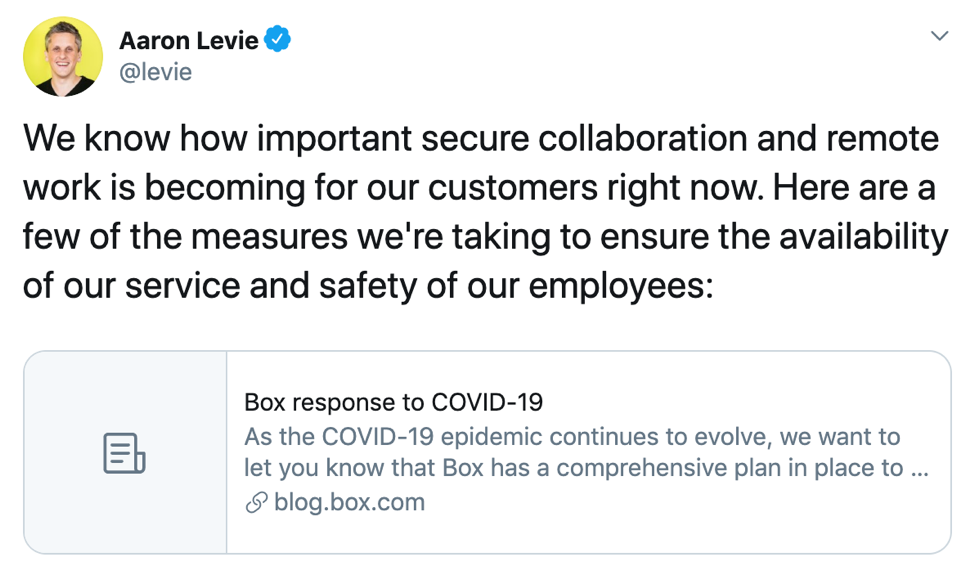Presented by WorkRamp
As governments and health organizations mobilize to curb the spread of coronavirus (COVID-19), global companies are also playing a critical role in keeping their organizations safe with a simple policy: work-from-home.
No question, work-from-home policies have existed since long before the outbreak. But this is the first time companies are seeing what happens when a distributed work force is stress-tested by hundreds of thousands of employees at massive organizations like Twitter, Facebook, and Google.
Whether your company is embracing a work-from-home policy for the first time or readying an entire organization into going remote, this can be a tricky period to navigate.
Here are 5 tips for creating a productive work-from-home policy:
1. Use tools like Zoom to not only get work done, but also to feel connected
Of course, productivity tools like Slack and Zoom have already seen a significant increase in usage, as also evidenced by an uptick in stock prices (ZM +85% in 2020 and +45% in February). It reinforces the fact that these remote-friendly software tools are a critical part of the remote worker’s day-to-day, especially when it comes to getting work done and feeling less isolated.
The real challenge around remote work is finding ways for employees to feel connected to each other and the company when they are physically apart. The most successful companies incorporate face-time into their remote culture, whether it’s taking their 1:1’s over Zoom (rather than just a faceless phone call) or hosting virtual company-wide meetings.
At Twitter, their first virtual global all hands was hosted on Google Teams and Slack, a move that enabled a more creative and stronger two-way dialog between the leadership team and the employees.

2. Create a new training mindset just like Peloton did
To enable an entire company to function remotely, there needs to be a widespread cultural transformation and change in perception around the way we do work — and that goes beyond just buying new tools. Just as Peloton was able to prove that changing your mindset around exercise was more than simply purchasing expensive, at-home equipment, companies are having to demonstrate that changing your mindset around remote work is more than purchasing the right conferencing software.
It must be done by outlining clear expectations around individual productivity and team communication, building trust within distributed teams, and maintaining a positive culture that continues to celebrate wins remotely while connecting globally.
At WorkRamp, we’re seeing this approach to change management take off in the industry and championed by innovative customers like TripActions. With over 400 agents globally, the TripActions Support Organization focuses not only on ensuring a high caliber of resources across all locations, but also on having the flexibility to turn the same training into an in-person, remote, or blended learning experience.
In light of the coronavirus pandemic, organizational agility is key in building out training resources that are helping agents navigate through a tsunami of support tickets on trip cancellations.
“TripActions is committed to providing an amazing employee learning experience online and offline,” says Matt Cruz, Director of Learning & Development at TripActions. “We are always revisiting and strategizing ways to deliver these experiences so that we stay nimble through any organizational changes.”
3. Extend your perks to the home
Make the transition from in-office to home as seamless as possible by extending the same in-office benefits for newly remote employees. A prominent Y Combinator company extends office perks to the home by allowing employees to expense one meal a day and providing an equipment stipend to outfit their remote workspace.
Policy shifts like these allow companies to still embrace company values and help employees remain connected to the company, while minimizing disruptions during abrupt transitions. This also shows that remote work is not a downgrade from being in-office, but another version of what work should look like. It’s easy to play these off as ‘extra perks’ — but it’s really about setting up employees for success, no matter where they work.
4. Give your commute time back to your customers
Although working from home presents its own challenges, the fact that employees will save time by skipping the long office commute also presents new opportunities for organizations. Especially for customer-centric companies, this allows teams to dedicate that extra time to finding ways to improve the customer journey.
Every team should feel empowered to go out of their way to delight customers during a turbulent period — whether it’s finding time to develop a more robust pipeline during prime morning business hours or having more hands on deck to cut the support ticket SLA in half. As a result of a remote workforce, we’re seeing innovative organizations like Quantum Metric give their time back to their customers in the form of building new training resources on the new Quantum University.

5. Stay informed, not inactive
Experts have recently shared that “anxiety moves faster than a virus.” So while global organizations aim to keep their teams productive and engaged while staying safe, it’s important to remember that companies have a huge role to play in keeping their workforces positive and informed.
Companies like Coinbase have gone out of their way to create planning and response guides and policies that demonstrate that they care about their employees’ well-being. At the same time, company leaders are making sure to strike an important tone of support and opportunity. This is a chance for companies to demonstrate how to be nimble, value what is important, and keep moving forward.

An opportunity to become stronger and more resilient
Our hope is that companies come out of this pandemic even stronger and more resilient. Just as the financial crisis of 2007-2008 forced our banking infrastructure to improve its internal controls and balance sheets, we are extremely optimistic that companies will take this opportunity to learn how to enable global workforces, regardless of location or work environment. This opportunity will be a new direction for many, but one that will be used for years to come.
Ted Blosser is the CEO at WorkRamp, the leading end-to-end training platform for educating employees and customers at scale. Empower your users with an engaging learning platform that helps you execute better across your entire business. See why companies like Zoom, Square, and Slack trust WorkRamp to train their teams and customers by visiting https://www.workramp.com.
Sponsored articles are content produced by a company that is either paying for the post or has a business relationship with VentureBeat, and they’re always clearly marked. Content produced by our editorial team is never influenced by advertisers or sponsors in any way. For more information, contact sales@venturebeat.com.

